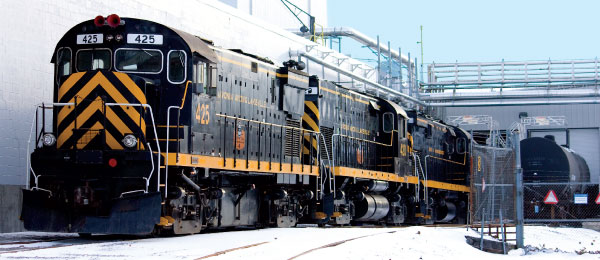Trends—February 2010

The Little Railroad That Did
Small railroad communities used to be widespread across the United States. Rural transportation and commerce were railroad-tied, each dependent on the other. In western New York towns such as Livonia, the past was very much aligned with the tracks. So is its future, thanks to a little foresight and determination.
Livonia, a town of 7,000 in the state’s Finger Lakes’ region, lays claim to 29 miles of track operated by the Livonia, Avon & Lakeville Railroad (LA&L). Forty-five years ago, the Erie-Lackawanna Railroad decided to abandon its branch line to Lakeville. Recognizing the threat posed by permanently losing the shortline rail service, a group of local business leaders with no railroading experience resurrected and reincorporated it as the LA&L.
"It was an ‘all-in’ bet at the time, and we were not sure we could make it work," says Gene Blabey, the railroad’s current president. Blabey was the Rochester, N.Y., bureau chief for United Press International and part of the 1964 acquisition and startup effort. "We felt there was potential, and we raised funds to cover the initial costs to get the railroad running. Then, we had to learn how to make ends meet with limited resources, and that was an eye-opener."
Freight traffic in the initial year amounted to a mere 50 carloads. To supplement sparse freight revenues, the LA&L began running passenger excursions. But it kept chugging along. In the late 1970s, the railroad dropped passenger service in favor of targeting freight, which received a boost when the railroads were deregulated in 1980.
"We had to be resourceful in the early years because revenue was meager, so we came up with creative solutions to keep things going. But our focus was always on service," explains Vince Milliken, vice president of customer service. "That paid off. As traffic increased to approximately 5,000 annual carloads in the past few years, we were able to reinvest to improve track, structures, and equipment."
Shortline railroads such as the LA&L are all about customer service, and that builds long-term partnerships with local businesses. Large domestic and international companies with production and distribution facilities on the LA&L benefit from the railroad’s responsive service and independent access to three Class I railroads. In 2008, Barilla, an Italian pasta manufacturing company, opened a $97-million facility in nearby Avon, joining a list of local rail shippers including Kraft Foods, Archer Daniels Midland, Sweeteners Plus, Perdue, and Cargill.
Today, the LA&L has grown to become a regional system. With two affiliated shortlines, it covers more than 400 miles of route in western New York and northwestern Pennsylvania. The railroad also contributes to the regional economy by promoting economic development—providing jobs, paying taxes, and purchasing goods and services.
"We started with very little and built a solid, long-term enterprise that provides environmentally friendly, competitive transportation services extending well beyond the region," notes Blabey.
For the town of Livonia, and others around the country, the LA&L is a parable that speaks to current economic development efforts as much as the past. If you think it, you can.
P&G Explores B2C
Conversations among Procter and Gamble (P&G) and its retail customers are a little awkward now that the consumer goods manufacturer—famous for its Tide detergent, Pampers diapers, and Gillette shavers—has entered the direct-to-consumer space. In a move that puts it in direct competition with retailers, P&G is bringing many of its popular brands to a Web site near you.
The manufacturer plans to launch an eStore in spring 2010, following a pilot with 5,000 consumers early this year. Owned and operated by PFSweb, a Plano, Texas, multi-channel outsourcing solutions provider, the online outlet will exclusively sell P&G products to U.S. consumers.
"As the growth in consumer Web commerce continues to evolve, we see a strong trend toward broadening consumer purchase interests into more product categories," says PFSweb CEO Mark Layton.
"With each new product category comes the opportunity to develop and test marketing, sales, and retention concepts," he adds. "Working with P&G on our eStore, we look forward to uncovering new insights and innovations that deliver on the potential of e-commerce as a powerful sales channel."
P&G sees this venture as a way to capture more accurate point-of-sale information—demand-side data that can help it better align new products and inventory with what buyers want. Given the impact of the economic downturn, shopping habits have become unpredictable as consumers weigh the economies of less-expensive generic brands against established name brands. The manufacturer plans to share this information with retail customers, dispelling worries that it is trying to compete for market share.
P&G will use the site as a consumer research lab, which Layton likens to a "giant sandbox for brands to play in." The eStore will test several concepts—product pairings, social media links, environmental sustainability, and packaging options—as it seeks to strengthen consumer relationships.
For P&G, growing a retail presence may well be a way to improve supply chain responsiveness—with the side benefit of creating a potential new sales stream.
